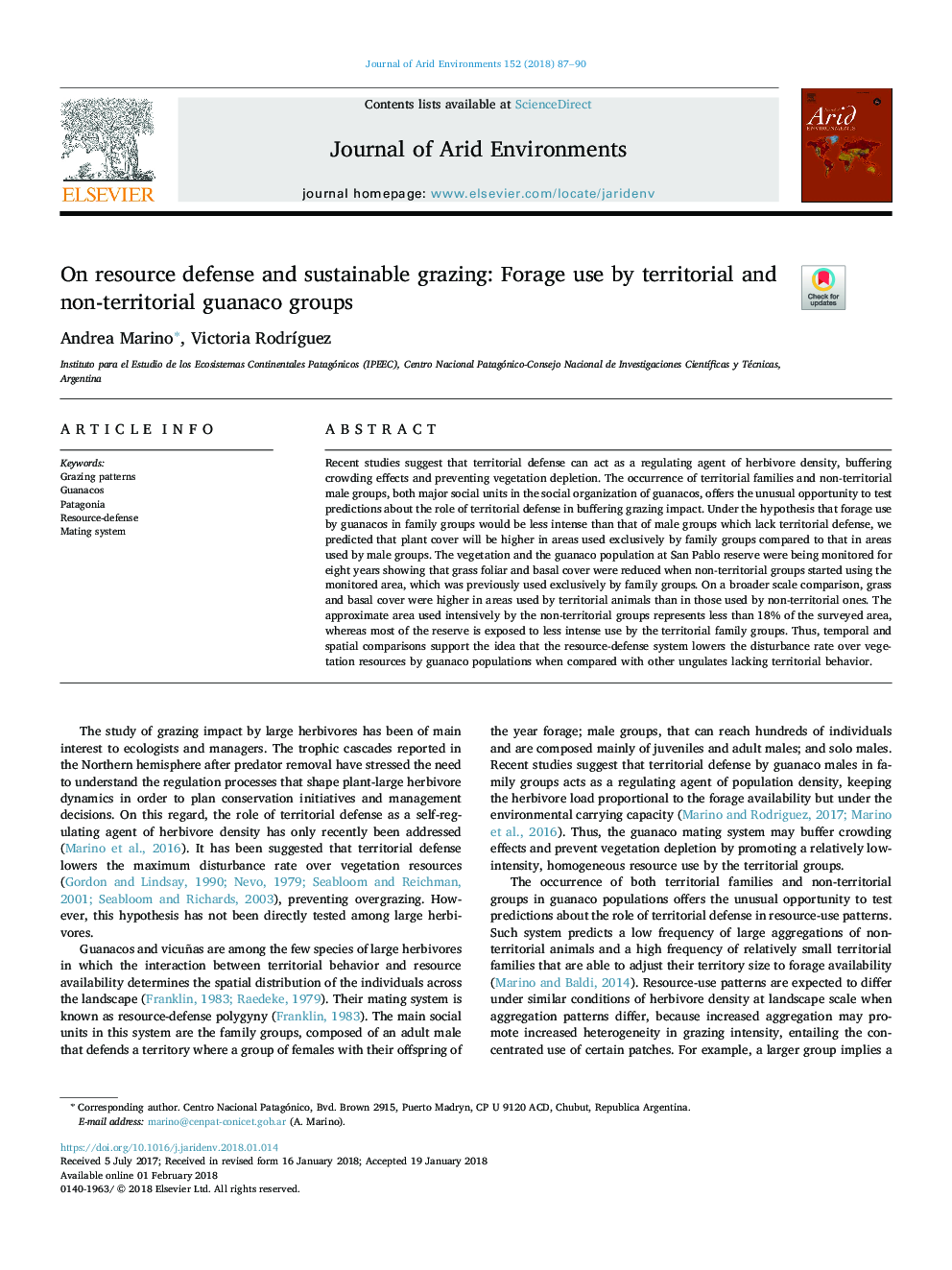| کد مقاله | کد نشریه | سال انتشار | مقاله انگلیسی | نسخه تمام متن |
|---|---|---|---|---|
| 8848533 | 1618207 | 2018 | 4 صفحه PDF | دانلود رایگان |
عنوان انگلیسی مقاله ISI
On resource defense and sustainable grazing: Forage use by territorial and non-territorial guanaco groups
ترجمه فارسی عنوان
حفاظت از منابع و چرخه پایدار: استفاده از غذا توسط گروه های گناکو منطقه ای و غیر ارضی
دانلود مقاله + سفارش ترجمه
دانلود مقاله ISI انگلیسی
رایگان برای ایرانیان
کلمات کلیدی
الگوهای گاو، گواناکوس، پاتاگونیا، دفاع از منابع، سیستم جفت گیری،
ترجمه چکیده
مطالعات اخیر نشان می دهد که دفاع منطقه ای می تواند به عنوان عامل تنظیم کننده چگالی گیاهان دارویی، بافت اثر انبساط و جلوگیری از فرار از پوشش گیاهی عمل کند. وقوع خانواده های سرزمینی و گروه های مردانه غیر سرزمینی، هر دو واحد اجتماعی مهم در سازمان اجتماعی گواناکو، فرصتی غیر معمول برای تست پیش بینی ها در مورد نقش حفاظت از قلمرو در تأثیر تأثیر گذاردر را ارائه می دهد. بر اساس این فرضیه که استفاده از علوفه گوازاکی در گروه های خانوادگی کمتر از گروه های مردانه است که از دفاع منطقه ای برخوردار نیستند، ما پیش بینی کردیم که پوشش گیاهی در مناطقی که به طور انحصاری توسط گروه های خانوادگی استفاده می شود نسبت به مناطق مورد استفاده توسط گروه های مردانه بالاتر باشد. پوشش گیاهی و جمعیت گواناکو در ساکنان سان پابلو برای هشت سال تحت نظارت قرار گرفتند و نشان دادند که گروه های غیرتاریخی از منطقه تحت نظارت استفاده می کردند که قبلا تنها توسط گروه های خانوادگی استفاده می شد. در مقیاس وسیع تر، پوشش چمن و پایه در مناطق استفاده شده توسط حیوانات ارضی بالاتر از موارد استفاده شده توسط مناطق غیر ارضی بود. ناحیه تقریبی که توسط گروه های غیرمتمرکز به شدت مورد استفاده قرار می گیرد، کمتر از 18 درصد از منطقه مورد بررسی را نشان می دهد، در حالی که اکثر ذخایر توسط گروه های خانوادگی ترجیح داده می شود. بنابراین، مقایسه های زمانی و فضایی از این ایده حمایت می کند که سیستم دفاع منابع کاهش میزان اختلال در منابع گیاهی توسط جمعیت های گواناکو را در مقایسه با سایر صدف هائی که فاقد رفتار ارضی هستند کاهش می دهد.
موضوعات مرتبط
مهندسی و علوم پایه
علوم زمین و سیارات
فرآیندهای سطح زمین
چکیده انگلیسی
Recent studies suggest that territorial defense can act as a regulating agent of herbivore density, buffering crowding effects and preventing vegetation depletion. The occurrence of territorial families and non-territorial male groups, both major social units in the social organization of guanacos, offers the unusual opportunity to test predictions about the role of territorial defense in buffering grazing impact. Under the hypothesis that forage use by guanacos in family groups would be less intense than that of male groups which lack territorial defense, we predicted that plant cover will be higher in areas used exclusively by family groups compared to that in areas used by male groups. The vegetation and the guanaco population at San Pablo reserve were being monitored for eight years showing that grass foliar and basal cover were reduced when non-territorial groups started using the monitored area, which was previously used exclusively by family groups. On a broader scale comparison, grass and basal cover were higher in areas used by territorial animals than in those used by non-territorial ones. The approximate area used intensively by the non-territorial groups represents less than 18% of the surveyed area, whereas most of the reserve is exposed to less intense use by the territorial family groups. Thus, temporal and spatial comparisons support the idea that the resource-defense system lowers the disturbance rate over vegetation resources by guanaco populations when compared with other ungulates lacking territorial behavior.
ناشر
Database: Elsevier - ScienceDirect (ساینس دایرکت)
Journal: Journal of Arid Environments - Volume 152, May 2018, Pages 87-90
Journal: Journal of Arid Environments - Volume 152, May 2018, Pages 87-90
نویسندگان
Andrea Marino, Victoria RodrÃguez,
